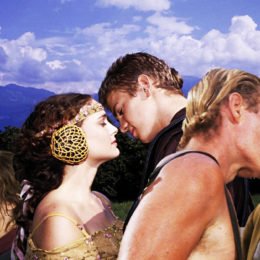The most HORRIBLE movie RAPE SCENES
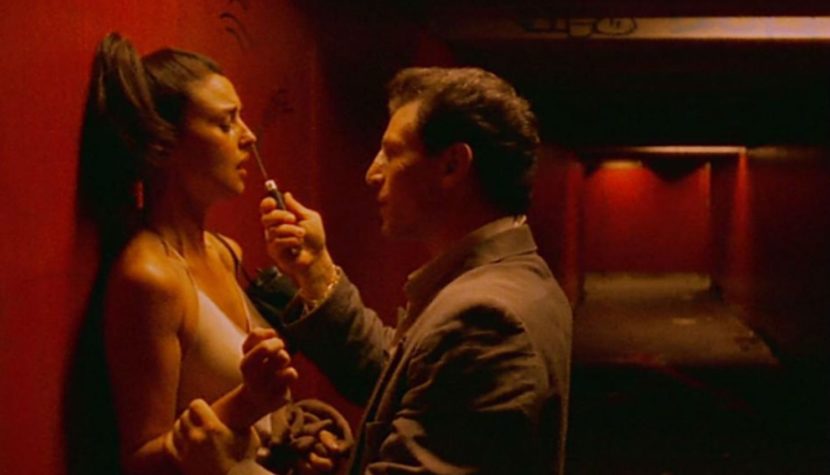
Cinema creators, aware of the impact of this motif, often reach for it – sometimes to cause pure shock, sometimes to say something important. Below I write about the rape scenes that shocked me the most.
Cargo 200 (2007, A. Bałabanow)
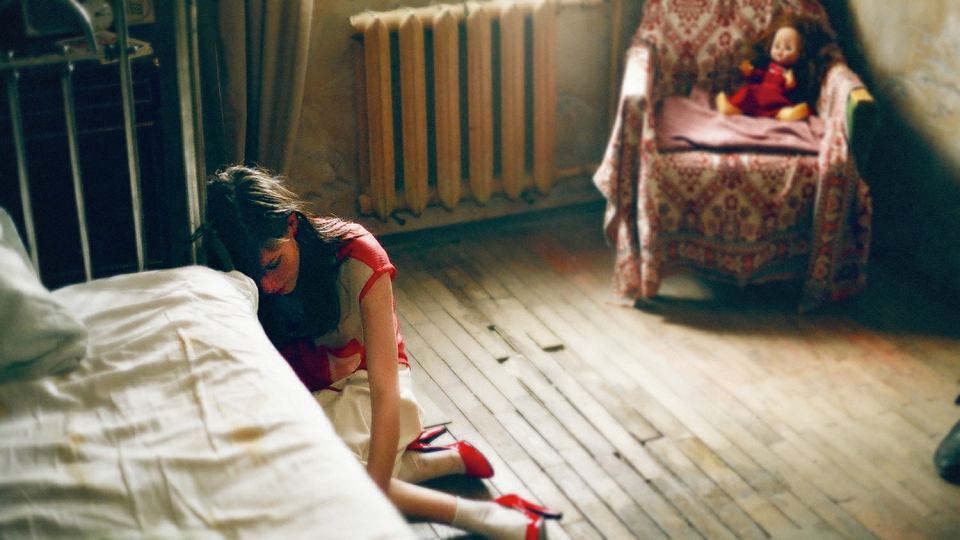
Watching Cargo 200 is like delving into the lowest circles of hell. One of the main characters in this terrifying Russian film is Andzelika, the daughter of a local party secretary from a provincial town. The girl, to her own misfortune, catches the eye of Captain Żurow. This is a man who embodies the degradation and pathology of the Russian militia with his whole being; behind the uniform and respectable position there is a dysfunctional sissy boy unable to create a normal relationship with a woman. Żurow, probably impotent, will rape Andżelika with objects and other people: he will deflower her with a bottle, imprison her in his own apartment and start “borrowing” her to his friends. All this time, the disturbed man will complain to his mother that Andżelika doesn’t want to like him… Rape here becomes a metaphor for the humiliation and decay of the Soviet communist society. What is most shocking is the ubiquitous callousness and stagnation. No one will help Andzelica, no one will be interested in her fate. The abuser’s mother who looks after the girl will be happy that her son has finally found a lover. The woman who shoots Żurov in the last scenes will look at Andżelika, who is chained to the bed, indifferently – and then she will simply leave without releasing her. Balabanow portrays people stripped of their humanity by the system.
Related:
Straw Dogs (1971, S. Peckinpah)
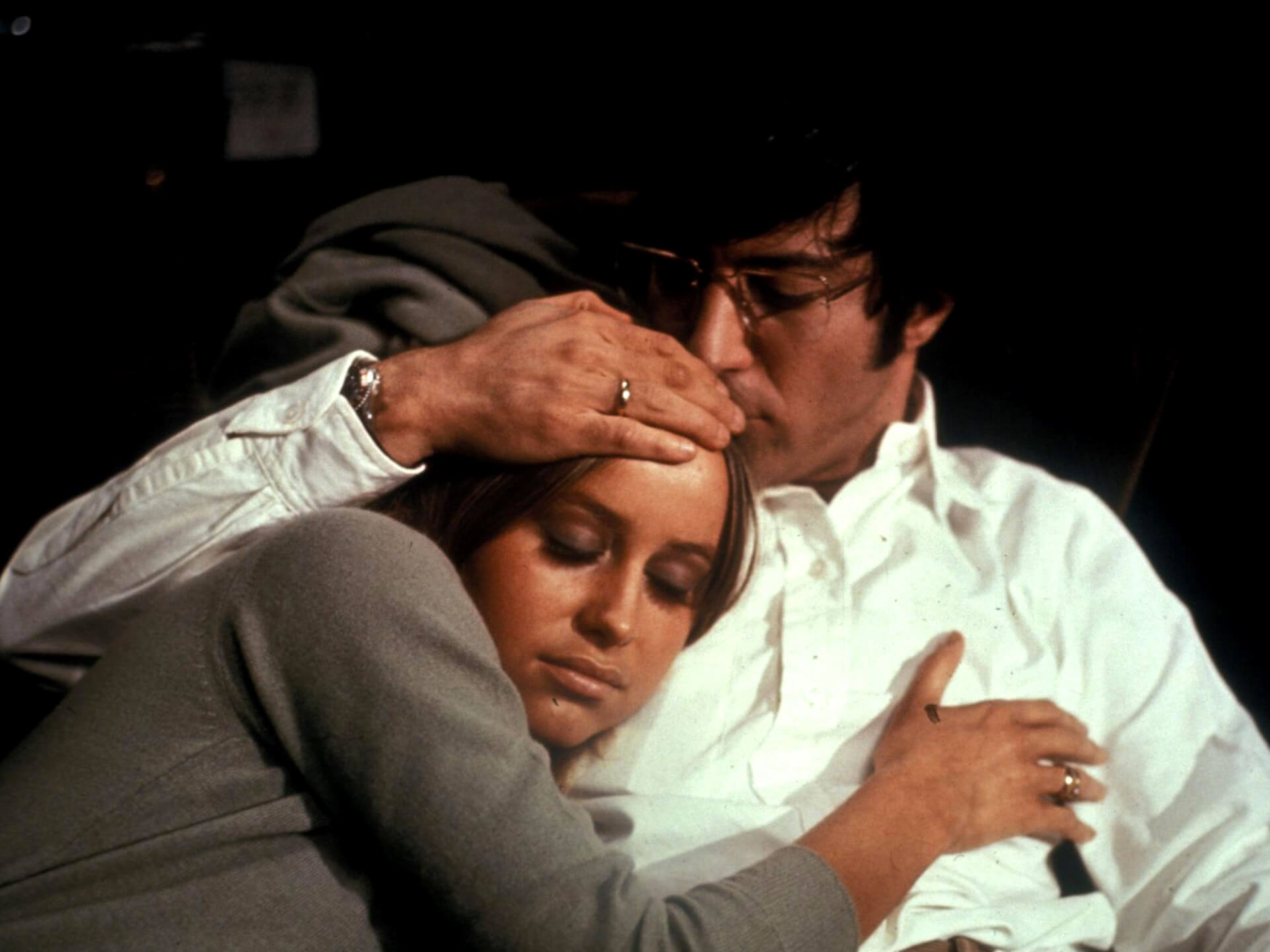
Bloody Sam has often been accused of misogyny, yet it was this director who managed to create one of the film’s most accurate vivisections of rape culture. In Straw Dogs, he paints a portrait of a province where violence in various forms flourishes under the guise of piety and the rule of law. The law of the stronger rules, men are cruel and primitive, and women assume the roles of sexual objects imposed on them. From this musty town comes the wife of the main character (Dustin Hoffman) played by Susan George. A married couple moves to the woman’s homeland and is ostracized from the very beginning. The main character is an intellectual, short and frail with glasses, which makes him unmanly in the eyes of the uncouth locals. There is also an element of jealousy in the provocations of the local guys, which is caused by the “new”: he comes from the big world, has the most beautiful girl from THEIR town as his wife – what did he do better than them, that she chose him? A collective, initially innocent, lynching of the protagonist begins: mockery of his masculinity, provocations, and finally physical violence and the killing of his cat. Finally, one of the local machos comes to the hero’s house and, taking advantage of the host’s absence, brutally rapes his wife, with whom he had a relationship in the past. Thus, he not only reduces the woman to the role of a trophy, an object (“I’ll take something that used to be mine”), but also sneaks into the enemy’s “territory” and desecrates it to prove who is stronger here.
The unbearably long and painful rape scene was edited in parallel with hunting shots, during which the main character performs his first act of aggression in the film: he kills birds. This redoubled escalation of violence and pain is an eloquent commentary on Peckinpah’s will to destroy that lies within every man. As overwhelming as the rape itself are the scenes right after it. Self-satisfied, emboldened in his masculinity, the husband returns from hunting, and his wife, on the one hand, cannot break down to tell what happened, on the other – she cannot pretend that everything is fine, which her partner, unaware of the tragedy, reads as a chimera and becomes unpleasant to her. Later, the couple goes to church, and the camera zooms in on the woman holding back tears, looking around nervously, jumping in the quick edit to the faces of the faithful – thus taking the perspective of the victim, perhaps looking for her tormentor in the crowd, perhaps wondering which of the gathered inhabitants of the hermetic community know about the rape and how it will be assessed by them.
The Girl with the Dragon Tattoo (D. Fincher, 2011)

Lisbeth Salander’s legal position is unenviable. Due to various problems and life turbulences, according to Swedish legislation, she is dependent on a top-down “guardian” – which makes her partially incapacitated in practice. This controversial law is subjected to even greater criticism in The Girl with the Tattoo because Lisbeth’s “guardian” forces sexual contacts on the girl in an extremely disgusting way. He blackmails and intimidates her, fully aware of his advantage over the protege. In one of the scenes, he orally rapes her, and Lisbeth’s tormented and resigned attitude proves that this is not the first time a man has committed such abuse. The most memorable, however, is the subsequent anal rape – exceptionally brutal even for Fincher’s films. This scene can be accused of unnecessary shocking violence, giving Lisbeth’s tormentor the features of a horror movie monster, crossing the borders of good taste, and even a certain exploitative kitsch. However, it should be appreciated that Fincher is not afraid to tackle difficult topics in films intended for a mass audience. The topic of sexual harassment Lisbeth draws attention to the unspoken problem of abuse of socially maladjusted people, which exists in care and education centres, orphanages, and psychiatric hospitals. Stieg Larsson described in his novels the flaw in the Swedish social welfare system, which allows carers of maladjusted people to commit various types of abuse. Fincher did not intend to remove this aspect from Lisbeth’s story, knowing how important it is to the character’s personality.
I Spit on Your Grave (M. Zarchi, 1978)

Horror cinema and sexuality have always gone hand-in-hand – rape in horror was sometimes given in the form of conjecture and joke (The Evil Dead), it was symbolic and understated (Alien), but it was also often literal, naturalistic and brutal. Many rape horror films are accused of portraying the act as sexy and attractive. The sexualization of violence is undoubtedly a legitimate indictment against many aspects of contemporary culture, not only horror movies (see Rihanna’s music video for Bitch Better Have My Money). Among horror and slasher films, however, there is a large group of films that deal with the subject of rape from a pro-woman, feminist perspective. This was the meaning of, for example, Teeth, in which the main character’s vagina, equipped with fangs, became her defense tool. Such was the overtone of the classic bloody independent cinema Ms .45, with a mute heroine taking revenge on random men for the harm she suffered. However, I Spit on Your Grave should be considered the godmother of the whole rape and revenge genre – a subgenre of exploitation cinema telling about the brutal revenge of a raped woman on her tormentors (or men in general). In the first act of I spit on your grave, we see extremely unpleasant, long and repulsive scenes of a gang rape of a young writer. In the later part of the film, we will support the woman in eliminating her abusers. The director of I Spit On Your Grave was inspired by his own experience of helping a rape victim. Shaken by this event, he wrote a scenario in which, at least in his imagination, he could bring justice to beasts who committed similar acts.
Last Tango in Paris (1972, B. Bertolucci)
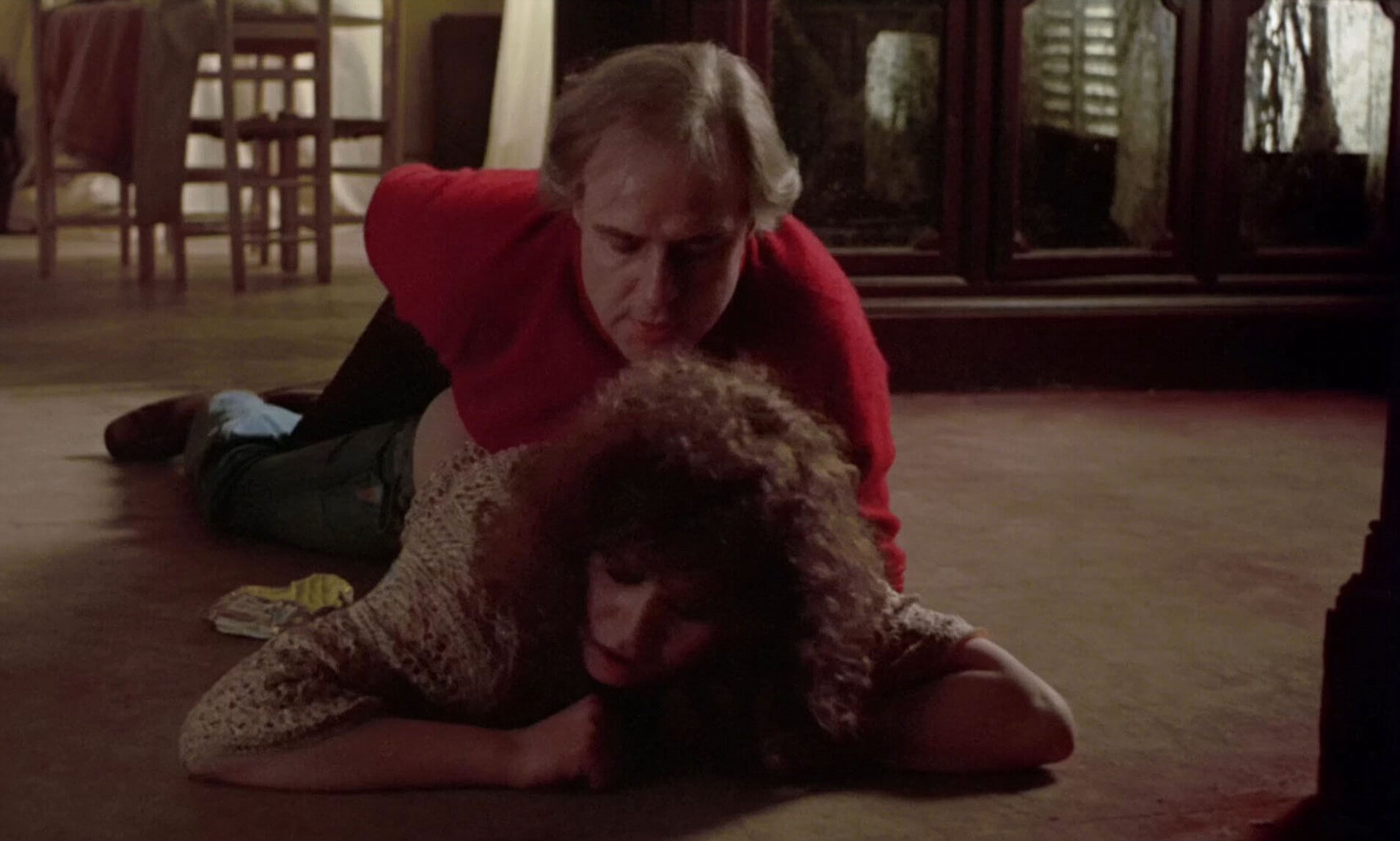
This one of the most controversial productions in the history of cinema may no longer shock as much as at the time of its premiere, but it is certainly not a film to be shown during a family dinner. Of all the sex scenes, the most infamous one was the one in which Paul rapes Jeanne anally, using butter as a lubricant. This act of violence is shown in all its brutality and unadorned naturalism. The rape scene in Last Tango in Paris becomes even stronger when you know the history of its shooting. Well, she wasn’t in the script at all. The director and the main actor, Bernardo Bertolucci and Marlon Brando, came up with the idea with violence. However, they decided not to tell Maria Schneider about their plans, whom Brando allegedly raped on camera. Bertolucci allegedly wanted the actress’s reaction to be as natural as possible, to behave like a woman who was really raped … Regardless of whether we consider Last Tango in Paris a good or bad film, the attitude of Bertolucci and Brando is morally indefensible. Only 19-year-old Maria Schneider was deprived of the opportunity to mentally prepare herself to shoot an extremely difficult scene. The actress felt humiliated, powerless, reduced to the role of an object. The event affected her as strongly as the “real” rape – she was treated psychiatrically for many years, which consequently led to the collapse of her promising career.
American History X (1998, T. Kaye)

Rape of men is still an embarrassing topic. Little is said about these acts of violence, and the statistics don’t lie: they happen every day – in military units, in prisons, in the family, in educational institutions – and most of them are never recorded. Worst of all, a raped man can rarely count on sympathy and understanding, most often he becomes the object of jokes, and his trauma is downplayed. The same is true in cinema, where male rape is very often used for comedic purposes. American History X is one of the few films that treats this subject with respect. Derek, played by Edward Norton, is a tough skinhead, an aggressive, radical guy who you wouldn’t want to meet in a dark alley. Sentenced to prison, he is raped by a fellow inmate in the shower – in a suggestive close-up we see Derek’s face full of suffering. The scene of the first meal after the rape is also exceptionally strong, when Norton’s hero slowly sits down at the table with effort: we can only guess what pain he feels. He eats alone, watched by the prisoners and his rapist: he has been stigmatized, he has fallen to the very bottom of the prison hierarchy. The rape strips Derek of his dignity, his masculinity, his self-esteem; it calls into question his whole developed personality, it attacks the foundations on which his identity was based. The former torturer and criminal himself is reduced to the role of a helpless victim. The tragic event also becomes the main stimulus for the hero’s metamorphosis.
Spetters (1980, P. Verhoeven)
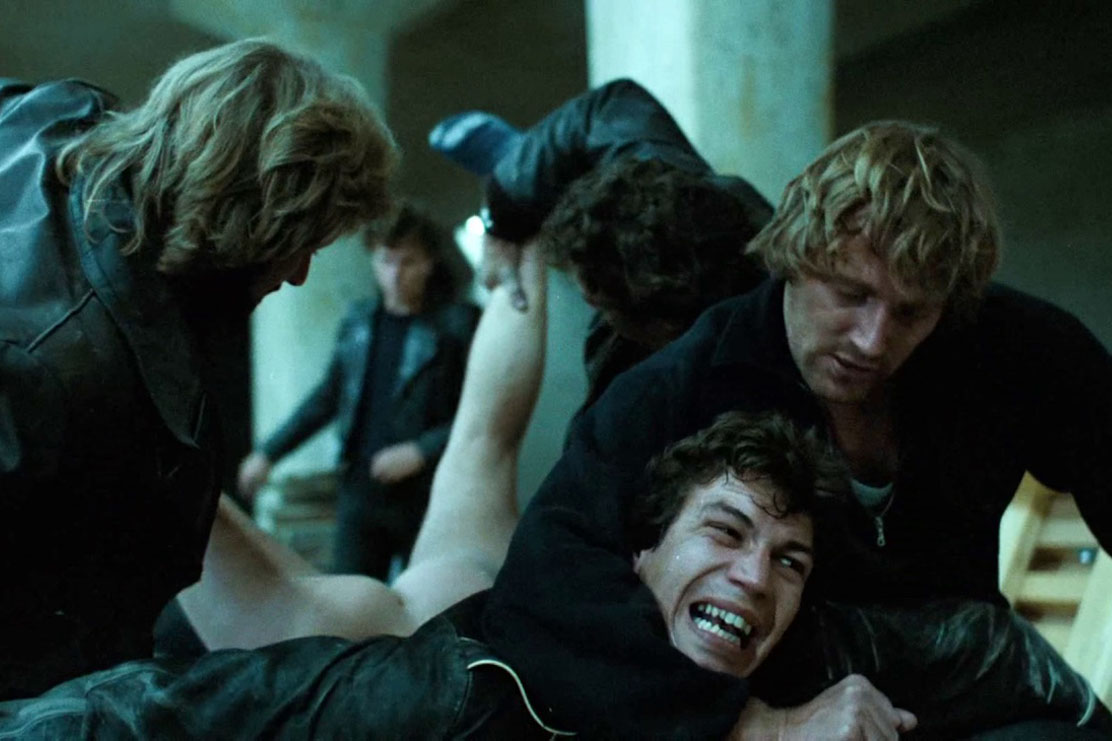
Another – even stronger – male rape scene can be found in Spetters. Paul Verhoeven’s early film is an ironic response to Hollywood, colorful productions about teenagers, such as Grease or Saturday Night Fever. Dutch youth is much more degenerate and immoral than American youth. Young people live in poverty, their lives are filled with overwhelming dullness, and dreams almost never come true. One of the three main characters, a mechanic, “moneys” himself by attacking male prostitutes and homosexuals. At first, the boy seems to be just a homophobe, but in the end it turns out that he actually feels homoerotic desires, which he represses. One night, he is attacked by a group of men led by his girlfriend’s brother. The boy is repeatedly raped, and the camera does not spare the viewers unpleasant images. Verhoeven shows spitting in the anus to aid penetration, twisting the legs to spread them as wide as possible, the victim’s face purple with pain and covered with veins. This extremely unpleasant rape scene fits the dirty atmosphere of the film and its strongly nihilistic overtones.
Flesh+Blood (1985, P. Verhoeven)

Paul Verhoeven for the second time. The Dutch director entered Hollywood with impetus, serving the audience an unprecedented, extremely suggestive vision of the Middle Ages. To this day, the scene of Martin’s (Rutger Hauer) rape of Princess Agnes (Jennifer Jason Leigh) remains exceptionally strong, in which a team of mercenary cutthroats led by him actively participates. The scene is terrifying because of the astounding joy with which a group of people rapes the weeping Agnes. In addition, the short Leigh looks at most 15 years old in this film, which is even more noticeable when compared to Hauer’s powerful figure. Perhaps most shocking of all, however, is the young princess’ reaction to the rape. Agnes, after the initial shock, begins to actively and willingly participate in the whole act, which astonishes her rapist. Later in the film, she knowingly seduces Martin and learns to manipulate him. Is the clever girl just trying to survive among the criminals? Or maybe as a result of the Stockholm syndrome, she really fell in love with her tormentor? The answers to these questions are suspended in a vacuum, because in the Middle Ages Verhoeven has no thought and no spirit. There are only flesh and blood. The director portrays people with a mentality far different from the modern one: living in the moment and governed by the most basic of instincts, roaming war-torn Europe like wild animals and dangerous predators. Western culture is still in its infant phase, so the people living in it are also like children: thoughtless, cruel and joyful.
Elle (2016, P. Verhoeven)

Paul Verhoeven for the third time – and I could still write about other rape scenes in his films, e.g. the one from Showgirls. The director is not interested in characters who are morally unambiguous and endowed with a simple psychological structure. The main character, played by the phenomenal Isabelle Huppert, is a complicated woman. Mature, knowing what she wants, wealthy – but at the same time having a certain darkness and even evil. When a man breaks into her house at the very beginning of the film and rapes her very brutally, the viewers get a clear and clear message: it will not be a nice and pleasant screening. And the rape scene itself among broken glass shards will not be the last shocking event that the director will serve us. Sexual harassment will awaken Michèle’s desires and instincts she didn’t know she had. The woman will start looking for more sensations on the verge of pain and pleasure, crave danger and risk. After discovering the identity of his rapist, he will draw him into a perverse game… Verhoeven without judgment or moralizing shows how twisted, ambiguous and elusive human sexuality is.
Once Upon a Time America (1984, S. Leone)

One of the film’s most memorable scenes is when Doodle rapes her teenage love, Deborah. The sexual assault of a man is extremely brutal; the character played by Robert De Niro pounces on the screaming woman like an animal, and there is nothing in his violent movements of the tenderness he declared a moment earlier when reciting to Deborah passages from the Song of Songs. The event takes place just before the gap dividing Leone’s monumental painting into two parts – and indeed it can be interpreted as a symbolic culmination of a certain stage. It can be said that in childhood, Max and Deborah fought a kind of duel for Noodles’ soul, trying to take it exclusively. While Max pushed the main character to do the worst things, persuaded him to take the path of crime and earn quick money, Deborah represented the world of beauty, noble ideals and higher aspirations, which Klucha, who reads Martin Eden, always longed for. For him, rape of his beloved is like revenge for false hopes and unfulfilled dreams. Finally, raping Deborah underscores the moral ambivalence of the main character. Leone doesn’t create crystalline, one-dimensional protagonists, and Once Upon a Time in America isn’t The Godfather. Dumpling can be gallant and romantic during the date, but if the chosen one refuses him sex after all, she will simply take it by force. This is not a world where gangsters who commit the worst crimes remain sweet and kind to their women. Noodles therefore rapes not only his beloved, but also the whole myth of a noble, knightly gangster created by Hollywood.
Irreversible (2002, G. Noé)
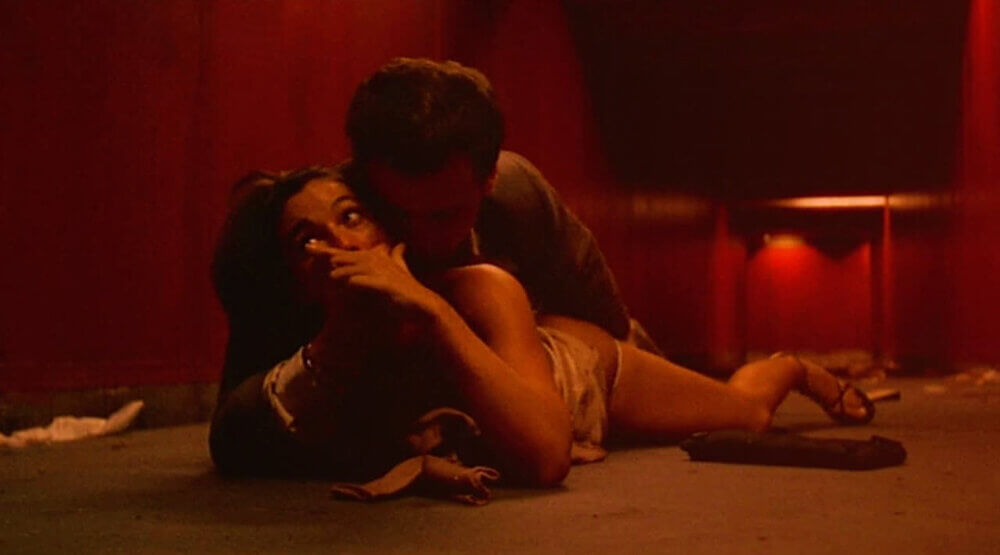
Almost everything has been written about this scene. It can easily be called the most famous rape scene in the history of cinema. Captured in a single, almost 14-minute shot, the assault, rape and beating of Alex attacked in an underground tunnel is an extremely difficult scene. Suffice it to say that the penetration itself lasts almost three minutes. The bestiality of the torturer, his mental and physical abuse of the victim make the whole shot unbearable, and the masterful acting by Monica Bellucci, who very credibly conveys the fear and suffering of the woman being harassed, makes us pray that this nightmare will finally end. You can read a detailed analysis of the rape scene from Irreversible HERE. It’s a bit of a pity that this one shot – although it proves the master craftsmanship of the creators – has become a kind of showcase of the entire film, which is labeled as shocking for the sake of being shocking. And this is a deeply moving story about the relationship of two people who love each other, whose common plans are irreparably ruined by rape. In addition, the whole is an interesting formal experiment: the events are presented from the end.
Strange Days (1995, K. Bigelow)
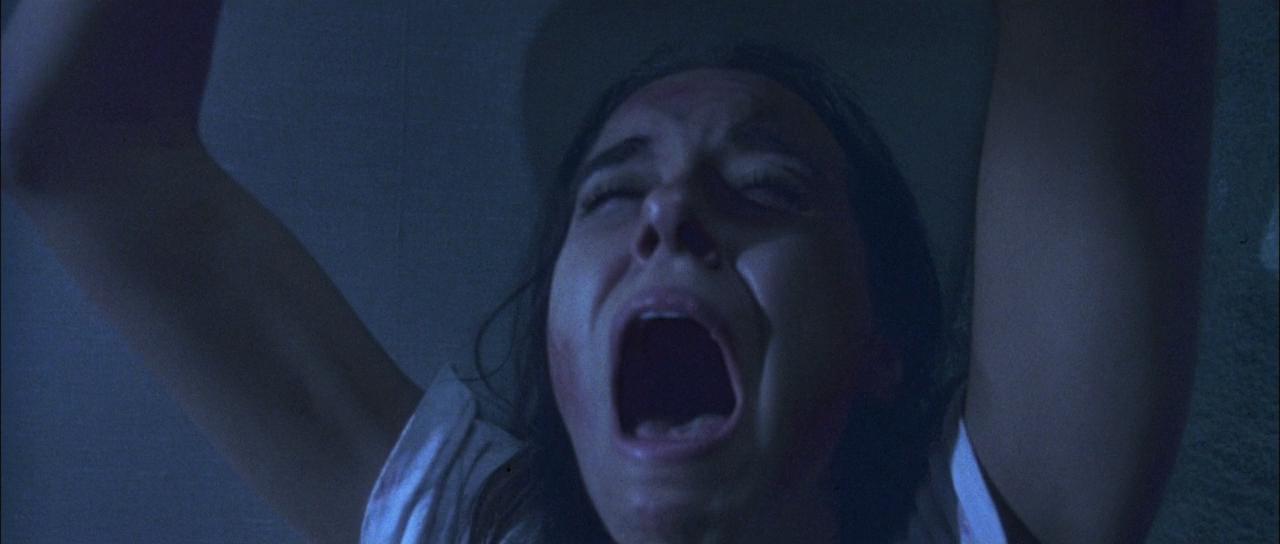
In this cyberpunk, very atmospheric story, people lose themselves in a futuristic, truly Cronenbergian entertainment – a special program that allows you to enter the memories of other people and feel their sensations. As you can easily guess, this type of invention quickly attracts amateurs of all kinds of perversions. The main character stumbles upon one of such perverted recordings, which is the turning point of the whole story. The video found is a record of a rape from the rapist’s perspective. The whole scene is terrifying not only with the realism of the found footage style and watching the event through the eyes of the perpetrator. What’s scary is how prophetic Kathryn Bigelow’s film turned out to be. After all, modern man has easier access to even worse recordings. The Internet and the dark web are bursting at the seams with them.
Hi, Tereska (2001, R. Glinski)
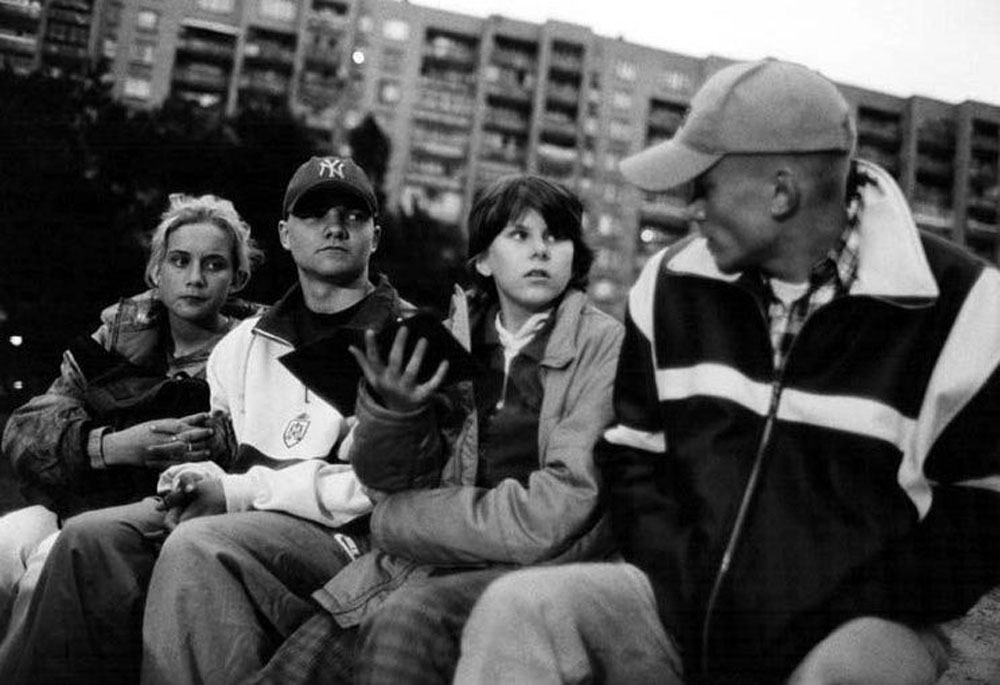
The title character’s first time turned out to be what her whole life has been – painfully disappointing. Tereska, until the moment of the rape, has a certain innocence and delicacy about her. She is not as perverted as her friend; it seems that after a youthful rebellion, she can still go straight, if only her parents take an interest in her or if she finds a strong enough motivation to change. The rape perpetrated on the girl by the boy she is in love with destroys the remains of good in her. The rapist decides that they have been dating long enough and simply lies down on Tereska – no foreplay, on the floor, ignoring her cries and protests. After this traumatic event, the teenager is additionally humiliated, because the boy tells his friends about the whole incident, who make fun of her. When in the next scene Tereska tortures Edzia – before presenting him with a fictitious, idealized version of her first time – we already know that the heroine has entered the road of no return. Greyness, boredom, pathology hidden under the guise of normality will destroy everything in her sad block of flats. Even love and tenderness.
Man Bites Dog (1992, A. Bonzel, B. Poelvoorde, R. Belvaux)

Natural Born Killers seem like a bedtime story for kids compared to this Belgian mockumentary. Man Bites Dog tackles similar issues as Oliver Stone’s film – such as the social, media-fueled fascination with violence and serial killers – but does so in an even crueler, more uncompromising way. Here we are watching a fictitious report from the everyday life of a murderer. This is also the ultra-realistic, quasi-documentary form of the gang rape scene – probably the strongest in the entire film. The episode resembles the robbery of the writer’s house in A Clockwork Orange – a laughing group of men in bubbly moods (it’s Christmas time) breaks into the apartment where a married couple is just making love. The film crew rapes the woman one by one, making fun of her husband in the process. There is such an escalation of bestiality that the entire scene becomes almost unwatchable. After everything, there is a time jump: we watch the panorama of the apartment after the crime. The black-and-white shot shows the massacred corpses of a married couple (a view as if from authentic photos of the Volhynian massacre) and the degenerates resting on the floor after the end of the “game” … For me, the rape scene from the movie Man Bites Dog remains the scariest of those I have ever seen, and the movie itself – one of the most shocking experiences that art has given me.
Deliverance (1972, J. Boorman)
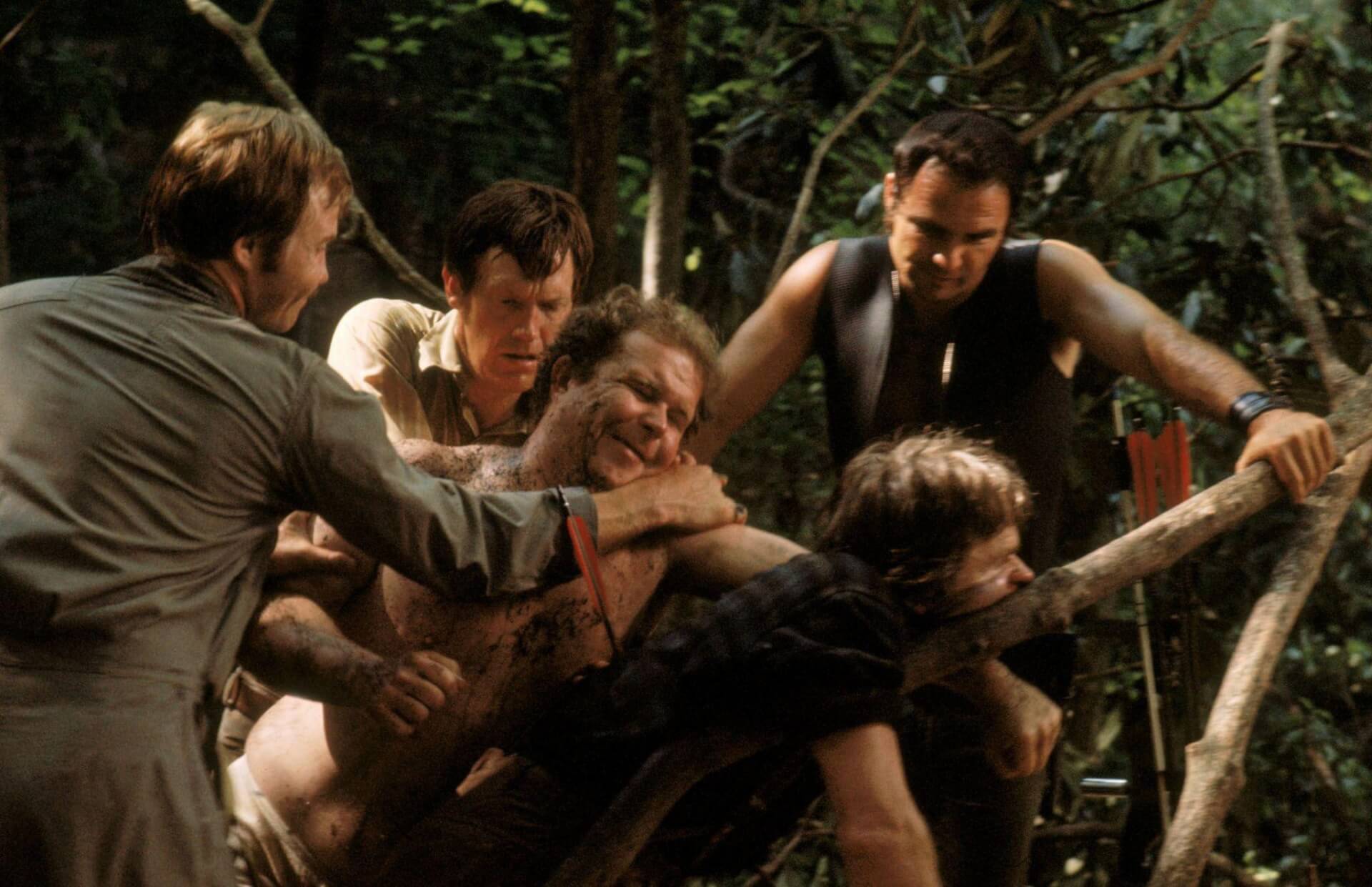
This somewhat forgotten film with John Voight and Burt Reynolds features an extremely eccentric rape scene. A group of men goes on an expedition to Appalachia, where they become the target of aggression of the local inhabitants. The indigenous people do not want visitors on their own territory and decide to teach one of the captured men, Bobby, a particularly cruel lesson. Their behavior is sick and feral. They strip him and then rape him. The torturer makes the raped man squeal like a pig, which poor Bobby eagerly does… The rape scene in Deliverance is, well, one of a kind. On the one hand, it is disgusting and terrifying, on the other hand, it contains something grotesque and a certain amount of exaggeration that puts the whole event in brackets.
Bad Timing (1980, N. Roeg)

Rape is not only an outlet for sexual desire, but also a demonstration of power, subjugating the victim, pacifying her. Bad Timing – a slightly forgotten, but great film by Nicolas Roeg – is an intense, sexually tense record of the unhealthy fascination of the American psychiatrist Alex (Art Garfunkel) with the young Czechoslovakian Milena (Theresa Russell). The girl is untamed, wild and sexually liberated; he doesn’t care about monogamy, family planning or settling down. He also hides many secrets that he does not intend to reveal to his partner. Throughout the film, Alex tries to decipher his fascinating lover, digs into her past, subjects the girl to tests like his patient. His infatuation becomes addictive, and his jealousy becomes a disease. In the end, he drives his partner, unwilling to meet his expectations, into serious mental problems. The culmination of Alex’s efforts is the rape of the unconscious, pale, sweaty, drugged Milena – the final subordination of the girl. The man who rapes his partner, who is in a drug-induced coma and unable to defend himself, appears to the viewers as a figure that is simultaneously repulsive, pathetic and arousing pity. He is small, thin, unattractive and ridiculous in his selfish attempt to seize another human being exclusively. And yet “only” goes to the extreme in what many lovers dream of – unconditional possession of a loved one.
A Serbian Film (2010, S. Spasojević)
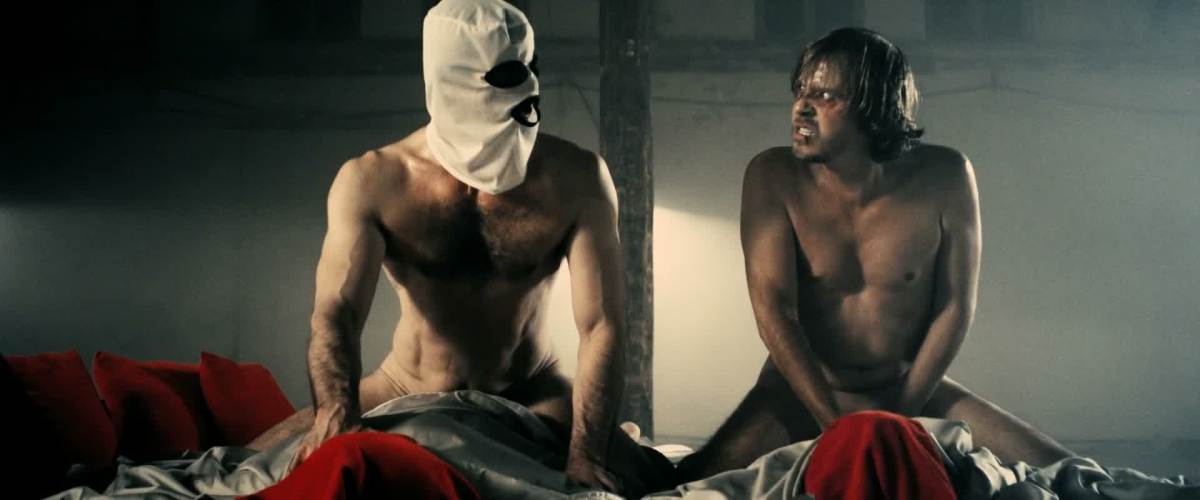
In the case of this extremely infamous picture, it is really difficult to choose only one rape scene. The entire A Serbian Film is an almost two-hour rape of the viewer. The story of a former porn star who decides to take part in a controversial “art” project for money is an accumulation of ugliness and grossness. However, two scenes are the most disgusting: the one in which the father rapes his son in front of the camera, and the one in which the man gives birth and then rapes the newborn … There are two reactions to the Serbian film (apart from the perverts who watch this type of production for excitement) . One group of viewers would love to pour a bucket of cement over the film so that no one would ever see it again. The second group sees a deeper bottom in this bizarre formation. Indeed, the Serbian film can be interpreted as a commentary on the progressive brutalization of the media, inventing more and more shocking tricks to attract people. It is also an exceptionally grim record of a moral decline, a story of human vagrants who will do anything for money. The director himself wanted to make his film a metaphor for Serbian society, symbolically raped by the war in Yugoslavia, during which, in front of the eyes of the whole world, terrible things were happening as in his work.
Salò, or the 120 Days of Sodom (1975, P. P. Pasolini)
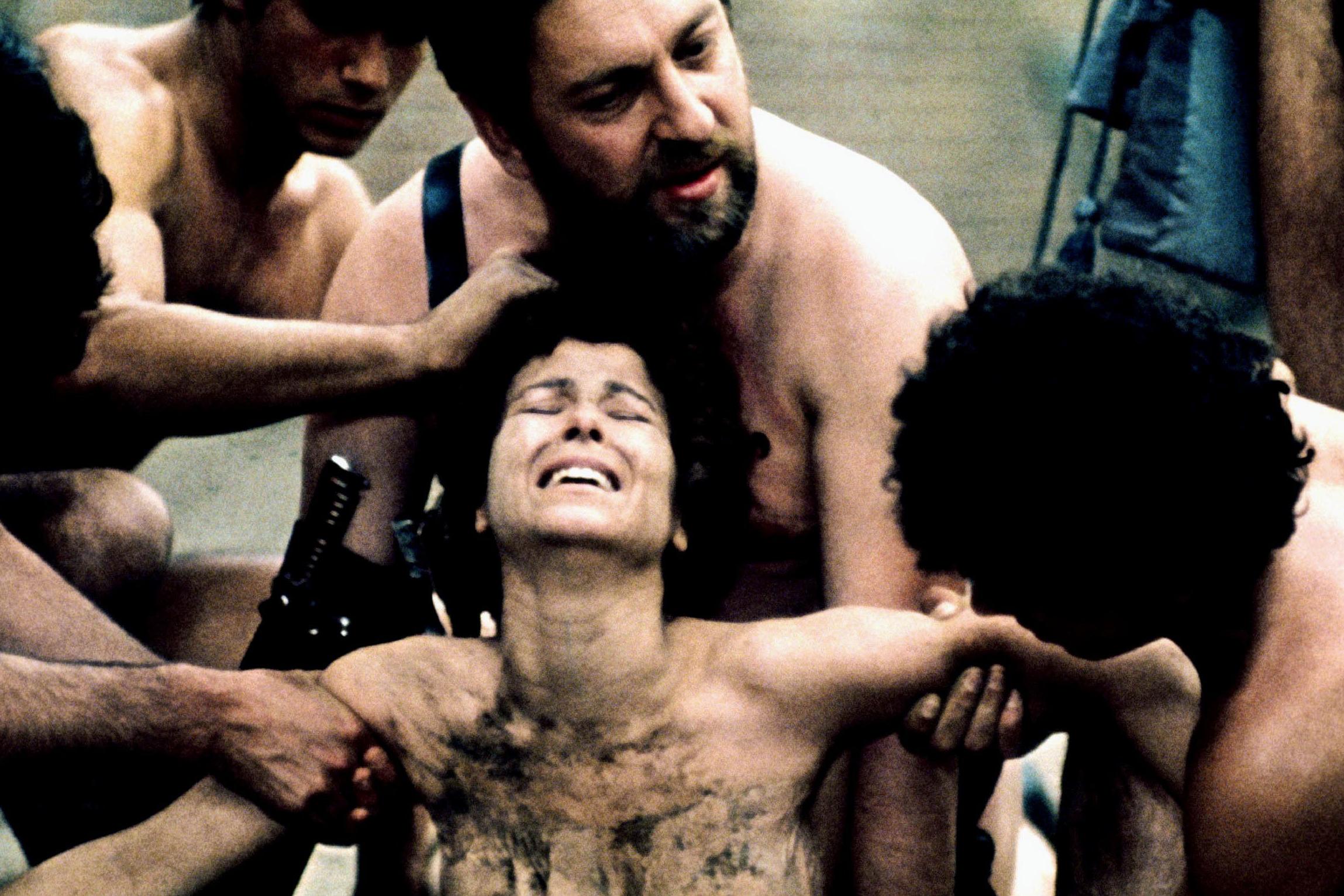
I wrote above about A Serbian Film that the whole picture is one big rape on the viewer. The same can no doubt be said of Salo. Pasolini’s last work is a veritable catalog of humiliations and harm that can be done to another human being. The film’s anti-heroes, fascists, have an orgy at the end of World War II. Young people from the area are forced to participate in it. Over the next few days, these sex slaves will be regularly raped – physically and mentally. Their tormentors will try to outdo each other in devising sophisticated ways to inflict pain on them as part of sadistic fun. The closer you get to the end, the harder it is to see it all. And let Salo finish this list. Those who watched this film know that it had to be here.



